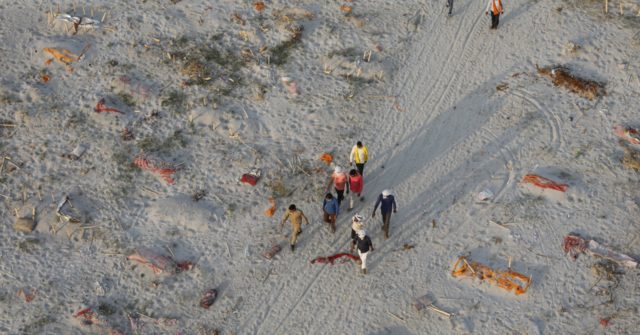Police are reaching out to villagers in northern India to investigate the recovery of bodies buried in shallow sand graves or washing up on the Ganges River banks
Hundreds of bodies found buried along Indian riverbanksBy RAJESH KUMAR SINGH and BISWAJEET BANERJEE Associated PressThe Associated PressPRAYAGRAJ, India
PRAYAGRAJ, India (AP) — Police are reaching out to villagers in northern India to investigate the recovery of bodies buried in shallow sand graves or washed up on the Ganges River banks, prompting speculation on social media that they’re the remains of COVID-19 victims.
In jeeps and boats, police used portable loudspeakers with microphones asking people not to dispose of bodies in rivers. “We are here to help you perform the last rites,” police said.
On Friday, rains exposed the cloth coverings of bodies buried in shallow sand graves on a wide, flat riverbank in Prayagraj, a city in Uttar Pradesh state. While officials say the riverside burials have taken place for decades, the sheer numbers in the shadow of the pandemic are focusing more attention on the practice.
Navneet Sehgal, a state government spokesman, on Sunday denied local media reports that more than 1,000 corpses of COVID-19 victims had been recovered from rivers in the past two weeks. “I bet these bodies have nothing to do with COVID-19,” he said.
He said some villagers did not cremate their dead as is customary, due to a Hindu tradition during some periods of religious significance, and instead disposed of them in rivers or by digging graves on riverbanks.
Ramesh Kumar Singh, a member of Bondhu Mahal Samiti, a philanthropic organization that helps cremate bodies, said the number of deaths is very high in rural areas, and poor people have been disposing of bodies in the river because of the exorbitant cost of performing the last rites and a shortage of wood. The cost of cremation has tripled up to 15,000 rupees ($210).
On Saturday, an Associated Press photojournalist estimated there were at least 300 shallow riverside graves on a sand bar near near Prayagraj. Each grave was covered by an orange, yellow or reddish cloth and appeared laid out in the same direction. Several policemen were at the scene, but allowed a family who arrived in a small truck to bury a 75-year-old woman at the site.
K.P. Singh, a senior police officer, said authorities had earmarked a cremation ground on the Prayagraj riverbank for those who died of COVID-19, and police were no longer allowing any burials on the riverfront. Authorities in Sehgal state have found “a small number” of bodies on the riverbanks, he said, but didn’t give a figure.
However, on Sunday, a 30-year-old Buddhist came to the same riverbank in Prayagraj with other family members and buried his mother, who he said had died of a heart attack.
“She was not infected with COVID-19,” Vijay Kumar told the AP, adding that his religion allows both cremation and burial, “but I chose burial.”
Health authorities last week retrieved 71 bodies that washed up on a Ganges River bank in neighboring Bihar state.
Authorities performed post mortems but said they could not confirm the cause of death due to decomposition.
A dozen corpses were also found last week buried in sand at two locations on the riverbank in Unnao district, 40 kilometers (25 miles) southwest of Lucknow, the Uttar Pradesh state capital. District Magistrate Ravindra Kumar said an investigation is underway to identify the cause of death.
India’s two big states, Uttar Pradesh and Bihar, with nearly 358 million people in total, are among the worst hit in the virus surge sweeping through the country with devastating death tolls. Hapless villagers have been rushing the sick to nearby towns and cities for treatment, many of them dying on the way, victims of India’s crumbling health care.
After hitting record highs for weeks, the number of new cases was stabilizing, said Dr. V.K. Paul, a government health expert.
The Health Ministry on Sunday reported 311,170 confirmed cases in the past 24 hours, down from 326,098 on Saturday.
It also reported 4,077 additional deaths, taking the total fatalities to 270,284. Both figures are almost certainly a vast undercount, experts say.

 www.breitbart.com
www.breitbart.com
Hundreds of bodies found buried along Indian riverbanksBy RAJESH KUMAR SINGH and BISWAJEET BANERJEE Associated PressThe Associated PressPRAYAGRAJ, India
PRAYAGRAJ, India (AP) — Police are reaching out to villagers in northern India to investigate the recovery of bodies buried in shallow sand graves or washed up on the Ganges River banks, prompting speculation on social media that they’re the remains of COVID-19 victims.
In jeeps and boats, police used portable loudspeakers with microphones asking people not to dispose of bodies in rivers. “We are here to help you perform the last rites,” police said.
On Friday, rains exposed the cloth coverings of bodies buried in shallow sand graves on a wide, flat riverbank in Prayagraj, a city in Uttar Pradesh state. While officials say the riverside burials have taken place for decades, the sheer numbers in the shadow of the pandemic are focusing more attention on the practice.
Navneet Sehgal, a state government spokesman, on Sunday denied local media reports that more than 1,000 corpses of COVID-19 victims had been recovered from rivers in the past two weeks. “I bet these bodies have nothing to do with COVID-19,” he said.
He said some villagers did not cremate their dead as is customary, due to a Hindu tradition during some periods of religious significance, and instead disposed of them in rivers or by digging graves on riverbanks.
Ramesh Kumar Singh, a member of Bondhu Mahal Samiti, a philanthropic organization that helps cremate bodies, said the number of deaths is very high in rural areas, and poor people have been disposing of bodies in the river because of the exorbitant cost of performing the last rites and a shortage of wood. The cost of cremation has tripled up to 15,000 rupees ($210).
On Saturday, an Associated Press photojournalist estimated there were at least 300 shallow riverside graves on a sand bar near near Prayagraj. Each grave was covered by an orange, yellow or reddish cloth and appeared laid out in the same direction. Several policemen were at the scene, but allowed a family who arrived in a small truck to bury a 75-year-old woman at the site.
K.P. Singh, a senior police officer, said authorities had earmarked a cremation ground on the Prayagraj riverbank for those who died of COVID-19, and police were no longer allowing any burials on the riverfront. Authorities in Sehgal state have found “a small number” of bodies on the riverbanks, he said, but didn’t give a figure.
However, on Sunday, a 30-year-old Buddhist came to the same riverbank in Prayagraj with other family members and buried his mother, who he said had died of a heart attack.
“She was not infected with COVID-19,” Vijay Kumar told the AP, adding that his religion allows both cremation and burial, “but I chose burial.”
Health authorities last week retrieved 71 bodies that washed up on a Ganges River bank in neighboring Bihar state.
Authorities performed post mortems but said they could not confirm the cause of death due to decomposition.
A dozen corpses were also found last week buried in sand at two locations on the riverbank in Unnao district, 40 kilometers (25 miles) southwest of Lucknow, the Uttar Pradesh state capital. District Magistrate Ravindra Kumar said an investigation is underway to identify the cause of death.
India’s two big states, Uttar Pradesh and Bihar, with nearly 358 million people in total, are among the worst hit in the virus surge sweeping through the country with devastating death tolls. Hapless villagers have been rushing the sick to nearby towns and cities for treatment, many of them dying on the way, victims of India’s crumbling health care.
After hitting record highs for weeks, the number of new cases was stabilizing, said Dr. V.K. Paul, a government health expert.
The Health Ministry on Sunday reported 311,170 confirmed cases in the past 24 hours, down from 326,098 on Saturday.
It also reported 4,077 additional deaths, taking the total fatalities to 270,284. Both figures are almost certainly a vast undercount, experts say.

Hundreds of bodies found buried along Indian riverbanks - Breitbart
Police are reaching out to villagers in northern India to investigate the recovery of bodies buried in shallow sand graves or washing up on the Ganges




